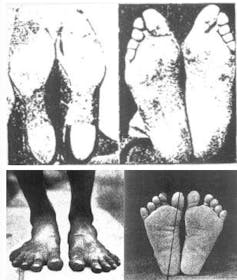Walking barefoot can help us connect with nature and, from an emotional point of view, with ourselves.
In recent decades, the custom of walking “with clean feet” has gained more and more followers. While some see it as a passing fad, others argue that it is a healthy practice, rooted in our very nature.
In fact, many parents of children who are not yet able to walk are very concerned about the development of their children’s feet, which helps explain the widespread use of so-called minimalist footwear (which provides the experience of going barefoot) in children. But is it just as important for adults?
A masterpiece
The foot is not just an element for walking and supporting our weight. It is a complex biomechanical system made up of 28 bones specialized in as many functions that provide stability, balance, and efficiency when walking.
In just a few square centimeters, it ensures that we can carry out such a basic activity as moving from one place to another. In addition, the sole has almost as many nerve endings as the hands and is a great regulator of our posture and movement.
“It is a masterpiece of engineering and a work of art,” Leonardo da Vinci once said of our lower limbs.
Back to naturalness
Walking barefoot of one’s own free will is not a modern invention. Some ancient cultures believed that this established a direct connection with the earth. However, the invention of footwear prioritized protection and status over naturalness. In modern societies, it is an essential element of clothing, both for reasons of hygiene and social position.
Does it make sense to do without it many times? Scientific research shows that it might: doing so would promote connection with nature and, from an emotional point of view, with ourselves.
In terms of physical aspects, there are differences between walking with shoes and bare feet, and this has been known for some time. As early as 1905, Dr. Phil Hoffman compared the feet of people who walked both ways and found major differences between them, both in the form and function of the foot.

A 2015 systematic review backed Hoffmann up and found several key distinctions. The first is that walking barefoot increases the spread of the front part of the foot (the forefoot); that is, the toes can spread out and move into their natural position, improving body stability.
The lower limb needs space to adapt to the terrain and maximize grip and stability, while contemporary footwear bases said grip on the soles, which limits this adaptation.
Secondly, not wearing shoes allows for better distribution of pressure on the foot. However, whether or not we wear shoes does not seem to affect the risk of injury .
The alternative: minimalist footwear
There is a problem: it is well known that touching the ground directly with our unprotected soles carries risks on certain surfaces or terrains. One of the alternatives, which is in full swing, is minimalist footwear, which we have already briefly referred to above. It is characterized by a simple and light design that imitates the sensation and biomechanics of walking barefoot, without giving up protection against the elements and hard surfaces.
These features include a thin, flexible sole – with no drop or heel lift –, lightweight, and a wide toe box, with more width at the front. In contrast, conventional footwear has a narrow last that prevents the forefoot from being positioned correctly, with excessive support at the rearfoot (the back part). It also raises the heel, shortening the Achilles tendon.
Minimalist alternatives have proven their benefits in stability and reducing the risk of falls, as well as in preventing certain ailments such as bunions, Morton’s neuroma, or plantar fasciitis.
For runners, they appear to induce improvements in running economy and stride frequency. This generates greater mobility and stability in their legs, which contributes to a more efficient running form and less impact on the joints.
On the other hand, conventional footwear is believed to atrophy the foot muscles. Some studies have shown that wearing minimalist options not only improves the strength of the intrinsic musculature of runners’ feet but also significantly increases their longitudinal arch and elastic strength.
Additionally, a 2022 publication suggested that the introduction of this footwear appears to help maintain a higher plantar arch.
Some risks and contraindications
As we mentioned, walking completely barefoot is not without its dangers. Exposure to dangerous surfaces and lack of protection can lead to skin lesions or infections. Suffering from a disease such as diabetic foot is a reason to advise against it.
Furthermore, the systematic use of conventional footwear changes the shape, strength, and function of the foot, so starting to do sports with minimalist footwear without adaptation can increase the chances of injury by abruptly changing the biomechanics of walking.
In short, whether we decide to walk barefoot or do so with minimalist footwear, it is crucial to do so gradually and consider individual circumstances. This will optimize the benefits and avoid the risks.![]()























+ There are no comments
Add yours